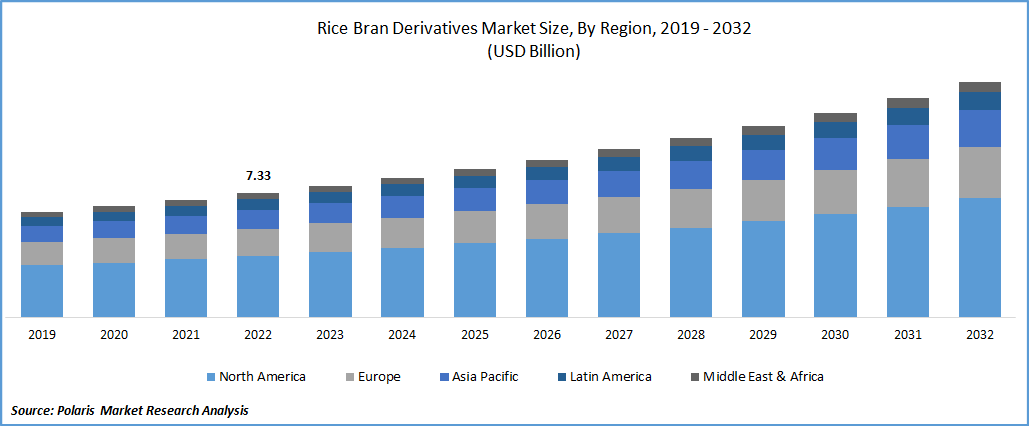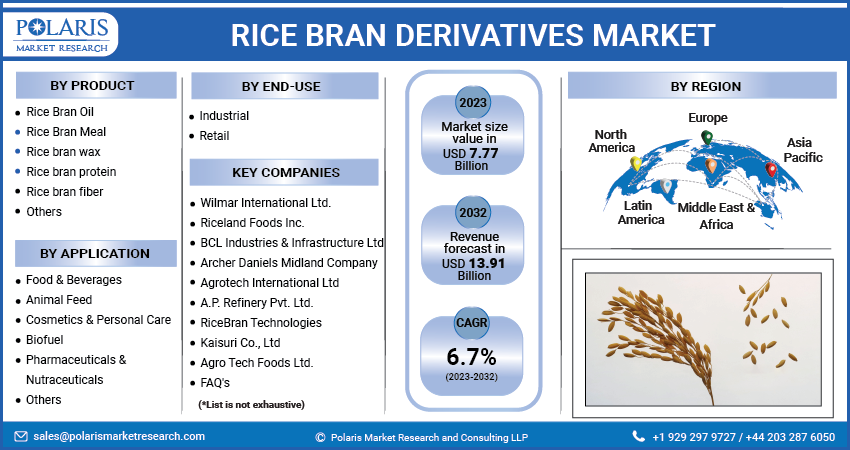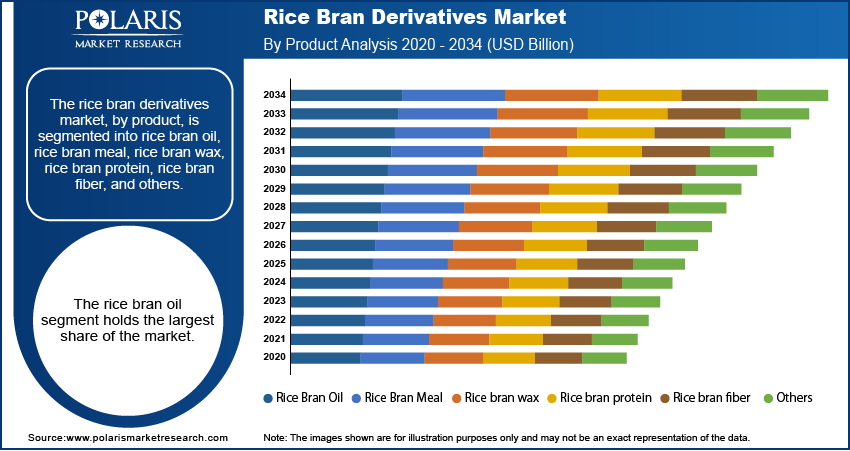
Rice Bran Derivatives Market Size, Share, Trends, Industry Analysis Report
: By Product, By Application, By End Use (Industrial, Retail), and By Region – Market Forecast, 2025–2034
- Published Date:May-2025
- Pages: 120
- Format: PDF
- Report ID: PM3228
- Base Year: 2024
- Historical Data: 2020-2023
Market Overview
The rice bran derivatives market size was valued at USD 7.23 billion in 2024. It is projected to grow from USD 7.62 billion in 2025 to USD 12.44 billion by 2034, exhibiting a CAGR of 5.6% during 2025–2034.
The rice bran derivatives market encompasses products derived from rice bran, the outer layer of the rice grain removed during milling. Derivatives, including rice bran oil and rice bran meal, are valued for their nutritional content and versatile applications across various industries. Rice bran oil and rice syrup, rich in antioxidants and essential fatty acids, are used in food, cosmetics, and pharmaceuticals. Rice bran meal, a byproduct of rice milling, is gaining popularity in animal feed due to its high nutritional value. The market is driven by increasing health consciousness, expanding food & beverage sector, and the rising demand for natural and organic products.
The food & beverage sector utilizes rice bran as a flavor enhancer, oil extractor, and transporter of bioactive components. The cosmetics industry values rice bran derivatives for their moisturizing, antioxidant, and skin-nourishing properties. The increasing demand for healthy and natural food ingredients, coupled with the rising popularity of plant-based diets, further fuels the market expansion. Additionally, advancements in processing and extraction technologies, along with demand for rice husk ash, are contributing to the development of innovative rice bran derivative applications.

To Understand More About this Research:Request a Free Sample Report
Market Dynamics
Rising Health Consciousness and Demand for Natural Products
Consumers are actively seeking food and cosmetic products with natural and nutritional benefits, such as rice based products, which positions rice bran oil and other derivatives favorably. Rice bran oil is known for its high content of oryzanol, a powerful antioxidant, and its balanced fatty acid profile. The growing awareness of these health benefits is leading to increased demand for rice bran oil in cooking and as a functional food ingredient. Furthermore, the preference for natural ingredients in personal care products, such as red yeast rice, is boosting the use of rice bran extracts for their moisturizing and anti-aging properties. This growing consumer inclination toward healthier and natural products is a key factor propelling the demand for rice bran derivatives.
Expansion of Food & Beverage Industry
The continuous expansion of the food & beverage industry globally is a major driver for rice bran derivatives demand. Rice bran oil is increasingly being used as a cooking oil due to its high smoke point and neutral flavor, making it suitable for various culinary applications. Additionally, rice bran is being incorporated into processed foods as a source of dietary fiber and other beneficial nutrients. The versatility of rice bran derivatives in improving the nutritional value and functional properties of food products is further contributing significantly to their increased adoption within the food & beverage industry.
Increasing Use in Animal Feed
The growing recognition of the nutritional benefits of rice bran meal in animal feed is another significant factor driving the use of rice bran derivatives. Rice bran meal is a cost-effective source of protein, fiber, and essential nutrients for livestock and poultry. This economic advantages and nutritional value of rice bran meal are leading to its greater inclusion in animal feed formulations, thereby strongly contributing to the demand for rice bran derivatives.

Segment Insights
Market Assessment by Product
The market, by product, is segmented into rice bran oil, rice bran meal, rice bran wax, rice bran protein, rice bran fiber, and others. The rice bran oil segment holds the largest share. This dominance is attributed to its wide-ranging applications across the food and beverage, personal care, and industrial sectors. Rice bran oil is favored for its balanced fatty acid profile, high smoke point, and rich content of antioxidants, vitamins, and minerals. Its perceived health benefits, particularly its potential to lower cholesterol levels, further drive its demand as a healthy alternative to traditional oils and fats. The ease of availability and established use in various culinary applications also contribute to its significant market presence.
Market Evaluation by Application
The rice bran derivatives market, by application, is segmented into food & beverages, animal feed, cosmetics & personal care, biofuel, pharmaceuticals & nutraceuticals, and others. The food & beverages segment accounts for the largest share, primarily driven by the widespread use of rice bran oil as a cooking oil and as an ingredient in various food products. Its favorable properties, such as a high smoke point and neutral taste, make it a preferred choice for both household and commercial cooking. Furthermore, rice bran and its fractions are increasingly being incorporated into processed foods to enhance their nutritional content and functional attributes, contributing substantially to the segment's dominance.
The pharmaceuticals & nutraceuticals segment is anticipated to exhibit the fastest growth rate. This rapid expansion is fueled by the increasing recognition of the health-promoting properties of various rice bran extracts and compounds. The rising consumer interest in natural health supplements and functional foods is driving the demand for rice bran derivatives in the formulation of nutraceuticals and pharmaceutical products. The presence of bioactive compounds such as oryzanol and tocotrienols in rice bran further enhances its appeal in these health-focused applications, positioning the segment for substantial growth in the coming years.
Markey Assessment by End Use
By end use, the rice bran derivatives market is segmented into industrial and retail. The industrial segment holds a larger share. This is due to the substantial demand for rice bran oil and rice bran meal from various industries, including food processing, animal feed manufacturing, and cosmetics production. The large volumes of rice bran derivatives utilized as raw materials or ingredients in these industries contribute significantly to the dominance of the industrial segment. Furthermore, the established supply chains and integration of rice bran derivatives into industrial processes contributed to its leading position in terms of share.
The retail segment is anticipated to experience the fastest growth rate within the rice bran derivatives market. This growth is driven by increasing consumer awareness regarding the health benefits of rice bran oil and other derivatives, leading to higher demand in supermarkets, health food stores, and online retail channels. This growing preference for direct purchase by end consumers is fueling the rapid expansion of the retail segment.

Regional Outlook
By region, the rice bran derivatives market report provides insight into North America, Europe, Asia Pacific, Latin America, and the Middle East & Africa. Asia Pacific holds the largest share of the global market. This dominance is primarily attributed to the region's significant rice production, particularly in countries such as India, China, and Southeast Asian nations, which ensures a substantial supply of rice bran as a raw material. Furthermore, the increasing adoption of rice bran oil as a healthy cooking oil and the growing use of rice bran meal in the expanding animal feed sector across these countries contributed significantly to the region's leading position. The established presence of key processing industries and a growing awareness of the nutritional benefits of rice bran derivatives further solidify Asia Pacific's substantial share.
The North America market is anticipated to experience the highest growth rate during the forecast period. This rapid growth is driven by several factors, including rising disposable incomes, increasing health consciousness among consumers, and the expanding applications of rice bran derivatives in various sectors. The growing demand for functional foods and nutraceuticals, coupled with advancements in processing technologies and increasing market penetration in developing economies within the region, is expected to fuel significant industry development. Furthermore, supportive government initiatives promoting the utilization of agricultural byproducts such as rice bran are contributing to the market growth in North America.

Key Players and Competitive Analysis
A few of the major players active in the rice bran derivatives market include Riceland Foods; Archer Daniels Midland Company (ADM); Bunge Limited; Wilmar International Limited; Associated British Foods plc (ABF Ingredients); ITC Limited; Adani Wilmar Limited; Cargill, Incorporated; Unilever; and Tsuno Rice Fine Chemicals Co., Ltd. These companies are involved in the processing and distribution of various rice bran derivatives, catering to the demands of the food and beverage, animal feed, cosmetics, and other industries.
The competitive landscape of the industry is characterized by a mix of large multinational corporations and smaller regional players. Competition is based on factors such as product innovation, product quality, pricing strategies, and geographical reach. Companies are focusing on expanding their product portfolios to cater to the diverse application segments and are investing in research and development to explore new extraction techniques and applications for rice bran derivatives. Strategic collaborations, partnerships, and expansions are also common approaches adopted by players to enhance their market penetration and strengthen their position in this evolving market.
Riceland Foods, located in Stuttgart, Arkansas, USA, offers a range of rice-based products, including rice bran oil and rice bran meal. Their rice bran oil is marketed for its culinary uses and nutritional benefits, while their rice bran meal serves as a valuable ingredient in animal feed formulations. Riceland Foods' extensive network and established presence in the agricultural sector make them a relevant player in supplying rice bran derivatives to various end-use industries.
Wilmar International Limited, headquartered in Singapore, is a prominent agribusiness group with a significant presence in the processing and merchandising of agricultural commodities. Their offerings in the rice bran derivatives segment include rice bran oil, which is utilized in food applications and rice bran meal for animal feed. Wilmar's global operations and integrated supply chain enable them to serve a wide customer base across different regions, making it a substantial contributor to the market.
List of Key Companies in Rice Bran Derivatives Market
- Adani Wilmar Limited
- Archer Daniels Midland Company
- Associated British Foods plc
- Bunge Limited
- Cargill, Incorporated
- ITC Limited
- Riceland Foods
- Tsuno Rice Fine Chemicals Co., Ltd.
- Unilever
- Wilmar International Limited
Rice Bran Derivative Industry Development
- February 2025: The Indian government extended the ban on the export of de-oiled rice bran. This decision aims to ensure sufficient availability of this key ingredient for cattle and poultry feed in the domestic market and to control local prices.
Rice Bran Derivatives Market Segmentation
By Product Outlook (Revenue – USD Billion, 2020–2034)
- Rice Bran Oil
- Rice Bran Meal
- Rice Bran Wax
- Rice Bran Protein
- Rice Bran Fiber
- Others
By Application Outlook (Revenue – USD Billion, 2020–2034)
- Food & Beverages
- Animal Feed
- Cosmetics & Personal Care
- Biofuel
- Pharmaceuticals & Nutraceuticals
- Others
By End Use Outlook (Revenue – USD Billion, 2020–2034)
- Industrial
- Retail
By Regional Outlook (Revenue – USD Billion, 2020–2034)
- North America
- US
- Canada
- Europe
- Germany
- France
- UK
- Italy
- Spain
- Netherlands
- Russia
- Rest of Europe
- Asia Pacific
- China
- Japan
- India
- Malaysia
- South Korea
- Indonesia
- Australia
- Vietnam
- Rest of Asia Pacific
- Middle East & Africa
- Saudi Arabia
- UAE
- Israel
- South Africa
- Rest of the Middle East & Africa
- Latin America
- Mexico
- Brazil
- Argentina
- Rest of Latin America
Rice Bran Derivatives Market Report Scope
|
Report Attributes |
Details |
|
Market Size Value in 2024 |
USD 7.23 billion |
|
Market Size Value in 2025 |
USD 7.62 billion |
|
Revenue Forecast by 2034 |
USD 12.44 billion |
|
CAGR |
5.6% from 2025 to 2034 |
|
Base Year |
2024 |
|
Historical Data |
2020–2023 |
|
Forecast Period |
2025–2034 |
|
Quantitative Units |
Revenue in USD billion and CAGR from 2025 to 2034 |
|
Report Coverage |
Revenue Forecast, Market Competitive Landscape, Growth Factors, and Industry Insights |
|
Segments Covered |
|
|
Regional Scope |
|
|
Competitive Landscape |
|
|
Report Format |
|
|
Customization |
Report customization as per your requirements with respect to countries, regions, and segmentation. |
How is the report valuable for an organization?
Workflow/Innovation Strategy
The rice bran derivatives market has been segmented into detailed segments of product, application, and end use. Moreover, the study provides the reader with a detailed understanding of the different segments at both the global and regional levels.
Market Entry Strategies
A key growth strategy revolves around increasing market penetration by highlighting the nutritional advantages and diverse applications of rice bran oil and meal. Marketing efforts should focus on educating consumers and industries about the health benefits, cost-effectiveness, and sustainability aspects of these derivatives. Collaborations with food manufacturers, cosmetic companies, and animal feed producers can facilitate wider adoption. Exploring new product development, such as value-added rice bran protein or fiber ingredients, can also unlock further potential. Emphasizing the natural and non-GMO attributes of rice bran derivatives aligns with current consumer preferences and can be a strong growth driver.
FAQ's
The market size was valued at USD 7.23 billion in 2024 and is projected to grow to USD 12.44 billion by 2034.
The market is projected to register a CAGR of 5.6% during the forecast period.
Asia Pacific had the largest share of the market in 2024.
A few of the major players active in the market include Riceland Foods; Archer Daniels Midland Company (ADM); Bunge Limited; Wilmar International Limited; Associated British Foods plc (ABF Ingredients); ITC Limited; Adani Wilmar Limited; Cargill, Incorporated; Unilever; and Tsuno Rice Fine Chemicals Co., Ltd.
The rice bran oil segment accounted for the largest share of the market in 2024.
Following are a few of the trends: ? Increasing Demand for Healthy and Natural Ingredients: Consumers are increasingly seeking out food and cosmetic products that are natural and offer health benefits, driving the demand for rice bran oil and other derivatives rich in antioxidants and essential nutrients. ? Expansion of Applications in Food & Beverage Sector: Rice bran derivatives are finding wider applications as cooking oils, functional food ingredients, flavor enhancers, and sources of dietary fiber in the expanding food & beverage sector. ? Growing Use in Animal Feed: Rice bran meal is gaining popularity as a cost-effective and nutritious ingredient in animal feed formulations, driven by the rising global demand for animal protein.
Rice bran derivative refers to the variety of valuable components extracted and processed from rice bran, which is the outer layer of the rice kernel removed during the milling process. This byproduct is rich in oil, protein, fiber, vitamins, and antioxidants, leading to the production of key derivatives such as rice bran oil, utilized in cooking and various industries; rice bran meal, primarily used in animal feed; and specialized products such as rice bran wax, protein concentrates, and dietary fiber. These derivatives are gaining increasing importance due to their nutritional benefits, diverse applications, and sustainable sourcing from an agricultural byproduct.
